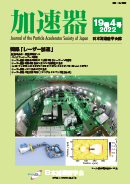Volume 19, Issue 4
Special Issue “Laser Acceleration”
Displaying 1-14 of 14 articles from this issue
- |<
- <
- 1
- >
- >|
Preface
-
2023 Volume 19 Issue 4 Pages 169
Published: January 31, 2023
Released on J-STAGE: January 31, 2023
Download PDF (384K)
Special Issue: Laser Acceleration
-
2023 Volume 19 Issue 4 Pages 170
Published: January 31, 2023
Released on J-STAGE: January 31, 2023
Download PDF (185K) -
2023 Volume 19 Issue 4 Pages 171-176
Published: January 31, 2023
Released on J-STAGE: January 31, 2023
Download PDF (1962K) -
2023 Volume 19 Issue 4 Pages 177-186
Published: January 31, 2023
Released on J-STAGE: January 31, 2023
Download PDF (1617K) -
2023 Volume 19 Issue 4 Pages 187-194
Published: January 31, 2023
Released on J-STAGE: January 31, 2023
Download PDF (1107K) -
2023 Volume 19 Issue 4 Pages 195-204
Published: January 31, 2023
Released on J-STAGE: January 31, 2023
Download PDF (1966K) -
2023 Volume 19 Issue 4 Pages 205-213
Published: January 31, 2023
Released on J-STAGE: January 31, 2023
Download PDF (1884K) -
2023 Volume 19 Issue 4 Pages 214-222
Published: January 31, 2023
Released on J-STAGE: January 31, 2023
Download PDF (1307K) -
2023 Volume 19 Issue 4 Pages 223-228
Published: January 31, 2023
Released on J-STAGE: January 31, 2023
Download PDF (1847K)
Forum
-
2023 Volume 19 Issue 4 Pages 229-232
Published: January 31, 2023
Released on J-STAGE: January 31, 2023
Download PDF (1711K)
Meeting Reports
-
2023 Volume 19 Issue 4 Pages 233-236
Published: January 31, 2023
Released on J-STAGE: January 31, 2023
Download PDF (6580K) -
2023 Volume 19 Issue 4 Pages 237-241
Published: January 31, 2023
Released on J-STAGE: January 31, 2023
Download PDF (1691K) -
2023 Volume 19 Issue 4 Pages 242-244
Published: January 31, 2023
Released on J-STAGE: January 31, 2023
Download PDF (4154K)
Recent PhD. Graduate
-
2023 Volume 19 Issue 4 Pages 245-248
Published: January 31, 2023
Released on J-STAGE: January 31, 2023
Download PDF (628K)
- |<
- <
- 1
- >
- >|
